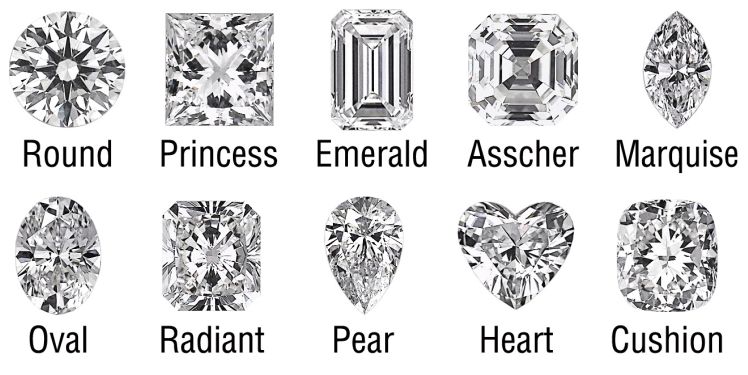
Diamonds come in a variety of shapes and cutting styles, here are some of the most popular:
Round: This is the most popular diamond shape, accounting for more than 75% of all diamond sales. A round diamond has 58 facets and is designed to maximize its brilliance and fire.
Princess: This square-shaped diamond is a popular choice for engagement rings. It has pointed corners and is designed to sparkle brightly.
Cushion: Also known as a pillow cut, this diamond has rounded corners and larger facets that enhance its brilliance.
Oval: An elongated shape with rounded edges, oval diamonds are often used in solitaire engagement rings.
Marquise: This diamond has a pointed, football-like shape that can elongate the finger of the wearer.
Pear: Also called a teardrop shape, this diamond combines the round and marquise shapes and is often used in pendants and earrings.
Emerald: This rectangular-shaped diamond has step-like facets that create a unique visual appeal.
Asscher: Similar to an emerald cut, the Asscher cut is square with cropped corners and larger step-like facets that give it a unique vintage look. This cut has a pointed culet.
Radiant: A square or rectangular diamond with cropped corners and a brilliant cut.
Heart: As the name suggests, this diamond is shaped like a heart and is often used in pendants and earrings.
This is a sample selection of the most popular and traditional shapes. There are many more shapes and cuts.
Not all shapes are price the same:
The most expensive shape of a diamond depends on several factors such as the quality of the diamond, its carat weight, and the market demand. However, generally speaking, round brilliant cut diamonds tend to be more expensive compared to other shapes, all else being equal.
This is because round diamonds are the most popular and in-demand shape, and the manufacturing process to create a round diamond involves cutting away more rough diamond material than other shapes, resulting in higher wastage. Additionally, the round brilliant cut is designed to maximize the diamond’s fire and brilliance, making it a very desirable choice for many people.
However, the price of a diamond ultimately depends on its unique characteristics and the market demand at the time of purchase.
Diamond of the same exact weight can look very different depending on the proportions and the shape
Diamond shapes that have larger surface area or table size relative to their weight will generally appear larger for their carat weight.
Therefore, diamond shapes that have a shallow depth or a large table are likely to appear larger than other shapes of the same carat weight. Here are some diamond shapes that are known for appearing larger for their carat weight:
Pear-shaped diamonds: The elongated shape and pointed end of a pear-shaped diamond give the appearance of a larger diamond.
Oval-shaped diamonds: Similar to pear-shaped diamonds, the elongated shape of an oval-shaped diamond can make it appear larger than other shapes of the same carat weight.
Marquise-shaped diamonds: The football-like shape of a marquise diamond can also make it appear larger for its carat weight.
Princess-cut diamonds: The square shape of a princess-cut diamond means that it has corners, which can make it appear larger than a round diamond if not cut with a depth over 70%.
Emerald-cut diamonds: The step-cut faceting of an emerald-cut diamond can make it appear larger, even though it has a smaller surface area than other shapes of the same carat weight.
Source: Michael Cohen DCLA